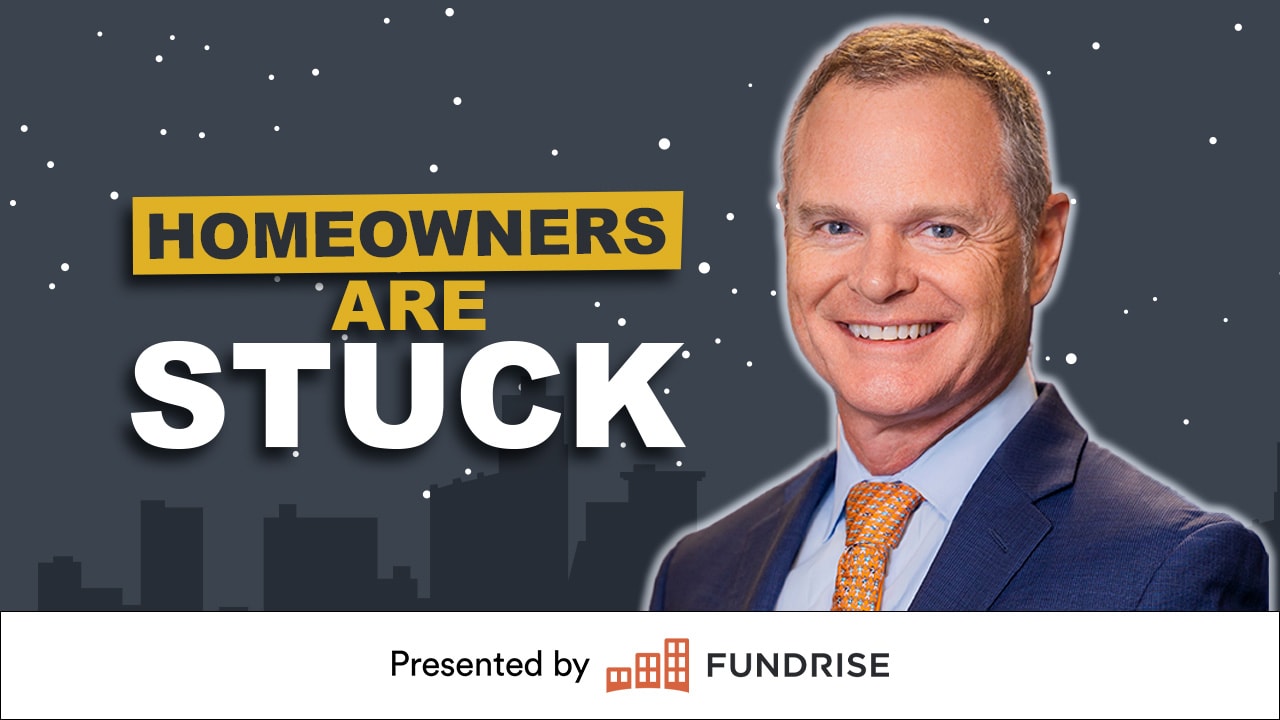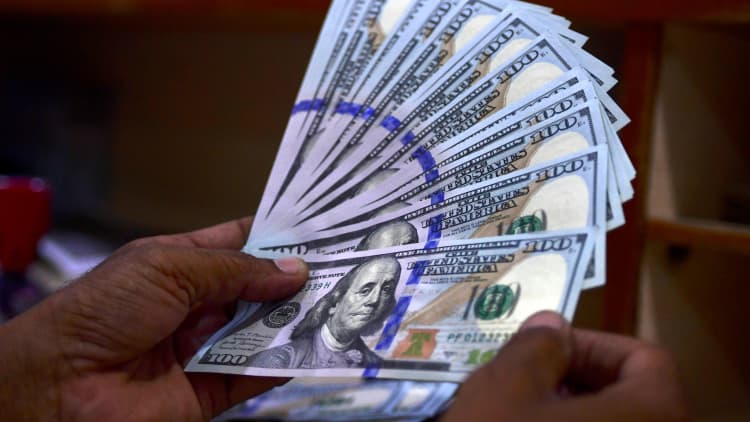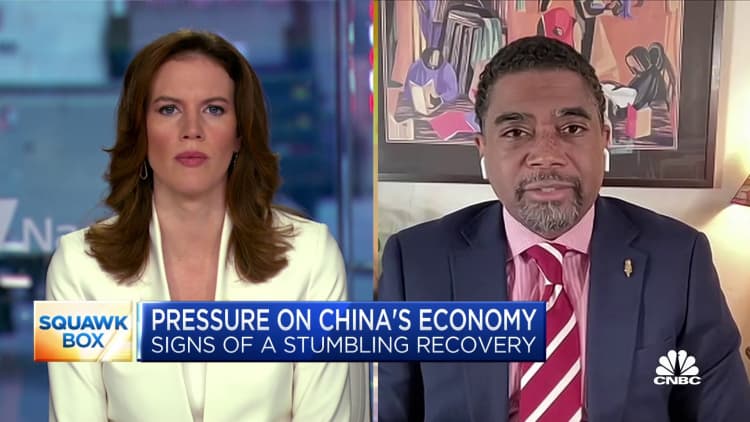Dave:
Hey, everyone, it’s Dave. Welcome to On the Market, and I’m going to completely lose my credibility here and just tell you all that we have one of our best shows ever. I know I just keep saying this, but we have had so many good guests and so many good episodes recently that I genuinely think this is true today. I am here by myself, as you can probably tell, but I am having a great conversation with Mark Fleming, who is the chief economist for First American. If you’ve never heard of First American, he explains it a little bit, but it’s one of the major title companies in the country.
Mark, who is a professional economist, and his team have built some incredible models that help us understand what is going on with home sales volume in a way I’ve honestly never heard before. People, I think headlines when you read the newspaper, listen to the media, always concentrate on home prices. That’s like the sexy thing to talk about. But the more you learn about the housing market, I think the more you see that one of the, if not the more important measure of the housing market health is actually the number of home sales that are going on. Because this doesn’t just affect investors, it affects real estate agents, loan officers, property managers, title companies.
The whole industry is really dependent on how many times a year homes are changing hands. Mark has built a really fascinating model to predict how many homes should be changing hands based on things like demographics, household formation, inventory, affordability. It’s really fascinating. I really had a great time having this conversation with Mark, and he tells it in such an engaging and easy to understand way. I think you guys are going to absolutely love this episode. If you do like this episode as much as I think you’re going to and as much as I did, please make sure to leave us review on either Apple or Spotify.
It takes just a couple of seconds and it means a whole lot to us. We are going to take a really quick break, and then we’re going to bring on Mark Fleming from First American. Mark Fleming, welcome to On the Market. Thanks for being here.
Mark:
My pleasure. Thank you for having me.
Dave:
Mark, can you just tell us a little bit about your involvement in the real estate world?
Mark:
Sure. I’m Mark Fleming. I’m the chief economist at First American. That’s the easy part. My involvement in the real estate world is… Well, first of all, I’ve been studying it as a real estate economist for my professional career a little over 20 years now. At the moment, in the capacity of chief economist of First American, my job is essentially to monitor the markets and understand what’s going on to help our business make the right decisions, as well as obviously provide lots of content to everybody who wants to listen to our podcast or read our blog posts and disseminate what we think might be of value to people who make decisions in this world.
Dave:
Wow, that’s great. You said for your business. I know First American is a giant title company, right?
Mark:
Yes. The thing that nobody knows or understands until they actually get involved in it. How many cocktail parties do people go to outside the real estate industry? Like title what? Title insurance, insurance that you own your property or insurance that the lender has first lien position rights on the loan that they give to you, critical in the closing of a transaction in most cases, whether it’s with a mortgage lender or a purchase.
Dave:
All right, great. What are some of the things that you’re following most closely in the unique housing market we’re in today?
Mark:
Yeah, very unique. I was talking to a colleague last week and they said, it must be really interesting right now with everything that’s going on. I thought, actually studying the market as an economist, the more bad things or odd things are happening, the more interesting my job gets, right?
Dave:
Oh, totally. Yeah, yeah.
Mark:
It’s not fun when it’s just growing 3% a year, right?
Dave:
I wouldn’t be on this podcast now, would I, if there was going to be nothing to talk about. We just went through a pandemic. I don’t think many real estate economists ever get that opportunity. It’s been a fascinating ride. Honestly, we look back historically at the real estate market. When was the last time it was normal?
Mark:
Yeah, that’s a great point. I don’t know. The ’90s?
Dave:
Yeah, exactly.
Mark:
We think somewhere in probably the late ’90s was about the last time it looked normal. We had a housing bubble in the first decade, the latter part of the first decade of the 2000s, and a very long and steady recovery for the last decade, a pandemic in 2020, cutting rates and inflation now. Yet all of these things are exciting. And because so much of what’s gone on in the last decade in particular has influenced interest rates in general and thereby mortgage and commercial real estate rates by association, we’ve ridden a low rate environment for the last 10 to 12 years. What’s most interesting now is that’s changing.
Dave:
Well, I want to ask you, you brought up something I’ve been wondering about. Are we just in a new normal? Like you said, it’s not normal, but do you think… If you look at the data back to I think like World War II is probably what I can think of in my mind, the housing market was much less volatile than it has been in the last 20 years. You just cited some reasons. Do you have any reason to believe that we are ever going to get back to that less volatile, stable linear growth, or do you think now the way the Fed policy is and things are working that the market is going to be a little bit more unpredictable?
Mark:
Obviously I think the volatility in the market is in large part driven by volatility of interest rates. You’re right, the latter half of the 20th century, most of it was more stable rates, although there are many that suggest that there’s an 18.6 year real estate cycle. Very specific there. Those 0.6 years are important.
Dave:
Okay, I haven’t heard that.
Mark:
That cycle has actually held in some way, shape, or form. Most of our data starts to come to bear in the late ’70s and early ’80s, so I like to start the time series charts in 1981 or 1980 when Paul Volcker was trying to ring inflation out of the economy. Sound familiar? And at that point drove, get this, the 10-year Treasury yield up beyond 10%. 10%.
Dave:
That’s wild.
Mark:
The 30-year fixed rate mortgage peaking in 1981 at 18.1%. Now, what happened? There was an affordability crunch. People lost a bunch of house buying power and the number of sales cut in almost half in the early ’80s because of that attempt by the Fed, successfully, to ultimately ring inflation out of the economy. Since then, I think your point is definitely valid. Once we got through that phase and interest rates basically started from 1981 up until just last year, a long run downward trend. At any point in time in all odds would be you buy your home. Two, three years later, you refinance it.
Why? Because rates are lower. Two, three years after that, you sell. Why? Because rates are lower. We’ve had that very, very long 40 year run essentially of declining rates, most recently hallmarked by a 10-year period over the last 10 years of rates at rock bottom rates. Mortgage is at four and three. I thought I’d never ever see it, but below 3% 30-year fixed rate mortgages last year and the year before.
Dave:
We’ve had some guests on this show who have suggested that given monetary policy, it’s really been swinging back and forth. It used to be, I guess, little less interventionist in the past and now it’s a little bit more maybe leading to continued volatility in interest rates. I know no one knows for sure, but I’m just curious if you have any thoughts on that.
Mark:
The economist in me wants to say, well, first of all, you have to understand that there’s monetary policy and there’s fiscal policy, and both need to be done potentially in concert with each other. I don’t know if that necessarily happens that well, but in lieu of fiscal policy, monetary policy has been used as the tool to try and do more. Of course, it really only operates through the financial markets. That’s how monetary policy works. When you try and do a lot with monetary policy, it doesn’t necessarily work as efficiently as fiscal policy does ultimately if you’re loosening policy economic stimulation.
But what it does do is it changes the behavior around the value of assets. That could be stock market assets, that could be bonds, that could be real estate. To your earlier point about volatility, I think the monetary policy has input volatility particular into our asset class of real estate in the last couple of decades for sure.
Dave:
And just to be clear, and Mark, you’re much smarter than I am, so correct me if I’m wrong here, but just to make sure everyone understands, monetary policy is basically what the Fed does. They control interest rates in a way, and they now do things like quantitative easing or tightening to control monetary supply. This impacts everything from inflation and obviously their goals are dual in controlling inflation and trying to maximize employment. Fiscal policy is basically the power of the purse, like what Congress does, basically how much is spent and on what.
As Mark was saying, both of them have huge impacts on the economy, but I think we’ve seen or at least felt the impact of monetary policy a bit more recently. But obviously fiscal policy, like the stimulus packages, for example during COVID, obviously also have big impacts on the economy.
Mark:
You did an excellent job in describing the two. Honorary degree in economics granted.
Dave:
Oh, thank you.
Mark:
I didn’t know you have that power, but that’s great. You’re absolutely right. The last couple of years have been fascinating because the pandemic was this unique circumstance where we loosened monetary policy, increased the money supply, encouraged consumption with less expensive money, lowering the interest rates, and at the same time, obviously very, very large fiscal policy packet. It was the double whammy to overcome the influences of COVID. The truth is now obviously we are suffering the consequences of all of that stimulus being put into the economy by both methods in the form of higher inflation.
Dave:
Yeah, absolutely. It was perfect storm of stimulus all at once. Great. Well, I diverge, but I enjoyed that. Thank you. But you were talking a little bit about just what you’re seeing in the housing market right now. We talk about a lot on the show, I feel like, the word of the year for the housing market is just inventory right now. We’re always just talking about inventory. But I’m curious what you make of the situation with inventory, given what we’ve already talked about. Is this do you think a trend that’s going to continue or we’re going to have a lot less on the market?
Because when I hear you saying, yeah, for basically 40 years, interest rates were going down and people had an incentive to move and to refinance, no one knows exactly what will happen, but it seems like we’re heading in the other direction. Do you think this could be a structural shift in the supply and demand dynamics in the housing market?
Mark:
Absolutely. I don’t call it inventory, I call it noventory, because that’s fundamentally the problem. You’re absolutely right. The last 40 years of that downward trending long run interest rate stimulated not only refinancing behavior, but most importantly for the housing market, purchase behavior, selling and moving, turnover in real estate parlance. Prior to the early 2000s, typical amount of time spent living in a home between two purchases was anywhere from five to seven years. That’s now almost 11 years.
Dave:
Wow!
Mark:
Yeah, so double, right? If you take a stock of 100 million, make the math easy, so there’s a little bit more of that, but 100 million residential housing units in the United States, if everyone’s turning over once every five years, you get a certain amount of volume of inventory. If they’re only turning over once every 10 years, it’s half as much. You have to go back and look, well, why were people selling so frequently on a five year cycle? That was because of declining interest rates. There was a built built-in incentive to move and buy the next house up and the next house up, and ultimately that new home for your family.
That move up buyer concept worked financially because rates were in the long run coming down. And now that has changed. Something like 80% plus of all mortgaged homes today have a mortgage of under 5%. That means most of those homeowners, if they were to make the move decision, there’s a financial penalty to be paid in. Even if they were to buy the same home back from themselves proverbially, it would cost them more per month because they’d lose that low rate, let alone the people at three and less than 3% mortgage rates. That turn to an upward rise in rates has created what we refer to as the rate locking effect.
We believe that is one of the fundamental reasons why we see a lack of inventory, and in particular, a lack of new homes being listed, because the vast majority of homes brought to market for sale are brought to market by an existing homeowner. That existing homeowner is very likely to have one of those mortgages, and it doesn’t make financial sense for them to move. There’s one other aspect to this, which gets a little trickier. You could call it the chicken and the egg problem. The economist game theory concept is the prisoner’s dilemma. I’m a prisoner. I have a dilemma, which is homes are unique.
I might not feel too strongly about the rate lock in effect. You know what? I’ll pay the penalty. I’ll want to move. The problem is, it’s not like I can just buy any home. Homes are what we refer to as heterogeneous goods. I need to try and find a home to buy that is better than the one that I live in today. Otherwise, why pay the penalty of the rate lock in effect? I’m trying to find something better to move into. Well, because you can’t just buy any home. The fewer homes there are to choose from, the riskier it is to make the sale decision, because the buy decision is being made at the same time, the seller and the buyer is often the same person.
You’re saying, I don’t know that I want to move or participate in the market because I’m worried about being able to find something that I like to buy. Another analogy that might resonate, it’s Match.com for homes. The more people there are on the Match.com site, the more likely it is I’ll be able to find just the right person to match my preferences. Housing is a matching problem as well. I have to find the home that I want to date the most and maybe marry in this analogy.
Dave:
That makes so much sense too though. With matching romantically, it’s not like there’s this time pressure where you have to make the decision to go look for a potential partner, and then you have a limited window to find that partner. But in the housing market, you often make the decision to sell your house before you’ve necessarily bought a new one because you need the money, the down payment for them, your sale to close before you purchase your next one. Is that the chicken and the egg thing? Because people, they have fear that it’s not worth taking that risk of putting their home on the market because there’s just nothing to buy.
Mark:
There’s nothing to buy. You fear not being able to find the home to buy once you make that decision. The prisoner’s dilemma issue here is that everybody’s sitting back and saying, “I’m not going to participate because I’m worried about being able to find somebody to buy because there’s not enough homes to date on the market.” But if everybody made the same decision to enter the market, there would be plenty of supply. The prisoner’s dilemma is it’s risky to be the first one.
Because if I make the decision and everyone else doesn’t, that’s bad. But if I make the decision and everybody else does too, then we’re all okay. The game theory that goes through this basically says everybody sits back and no one takes the chance. You get this housing liquidity problem, like the market seizes up for fear of being the first one and getting burned.
Dave:
We just need to coordinate somehow all these people who are thinking about selling and just get them all to list it on the same day.
Mark:
Exactly.
Dave:
Just have a Black Friday of housing inventory and kickstart the market again.
Mark:
It really is like a kickstart, how do you get the flow going and get people comfortable with the idea. I know if I sell, there’ll be plenty of options for something to buy.
Dave:
It’s so interesting just how much of economics, you obviously know this, but is just psychology and people’s fear. It’s a less than perfect science.
Mark:
Exactly.
Dave:
And at this point also the dismal science, unfortunately.
Mark:
Yes. As they say, the dismal science. Yes.
Dave:
I understand that you and your colleagues at First American, in order to understand this problem have developed a model to predict home sales and what they should be. Can you tell us a little bit more about that?
Mark:
That’s right. I mean, we always have to ask ourselves the question, since there’s been so much volatility in the number of home sales, we start to ask, well, what should it be? And then what should it be usually has us asking, well, what are the fundamental drivers of people wanting to sell homes or the amount of home sales that exist? Obviously a couple things come to mind. One is demographics. The faster the population is growing, the more households are being formed, the more demand there is for housing. The economic situation. People tend not to buy big, expensive purchases like a home if there’s a recession or they fear losing their job in the next 12 months.
The unemployment rate and the health of the economy is very important. And then affordability. Affordability gets a little trickier because affordability is a function of the interest rate, obviously, or the mortgage rate, but it’s also a function of what’s available to be purchased. For example, Jeff Bezos can buy any home. Affordability is high for him. At the other end of the income spectrum, the pickings get much smaller. The question is, how much of what’s available for sale is actually affordable to that potential first time home buyer who we classify as a renter? I don’t worry about demand and affordability for the existing homeowner.
They’ve solved the problem. They’re an existing homeowner. It’s that renter. We put all the information in about what are renter incomes, what are the mortgage rates, what is the trend in household formation, these fundamental drivers to estimate what we expect the underlying support is for the number of home sales. Right now it’s close to five.
Dave:
Close to 5 million annualized. Existing home sales, seasonally adjusted annualized rate, SAAR, million a year. What are we at? We’re at like 4.8 now.
Mark:
4.5 or 4.6. Yes, it’s not that far.
Dave:
4.6. 4.6. Okay.
Mark:
It’s a little under, but it’s not woefully under the expectation given the situation. Well, could it be higher? Yeah, it could be as high as six if we had lower mortgage rates and higher affordability, if we had more household formation. One thing that’s happened in the past 18 months is household formation has slowed down dramatically. That’s because in part, people coming out of college right now are like, wait a second, with all this uncertainty, I might just stay home. And also because we’ve just had a really big boom in household formation, demographically driven by millennials, that’s now fading.
All of these things are contributing to what the right amount is. We right now are attributing the difference between what we expected to be closer to five and where we are at 4.5, 4.6 to that rate lock-in inability to find something to buy problem because that’s really hard for us to model, if you will. We don’t have any data to know otherwise in the last four years.
Dave:
Wow! Super interesting. Okay, great. This is really helpful. It sounds like a really fun project from an economics and analytical standpoint. I respect that. I’d love to just break down some of those variables a little bit if you’re okay with that.
Mark:
Sure.
Dave:
First and foremost, you said household formation, and I just want to clarify with everyone what that is. We’ve talked about it a little bit on this show in the past, but basically a household is a group of people living together. It doesn’t necessarily have to be a group. Actually it could be an individual too, or it could be a family, roommates, that sort of thing. Basically how many independent people are living in unique houses.
That’s a great measurement for the housing market because it measures total demand both for rentals and owner occupied properties. I think you said something, Mark, that is really important that a lot of times I hear people conflate household formation and demographics. Demographics in my mind play a big part in household formation, but it’s also an economic decision, right?
Mark:
Exactly.
Dave:
There’s also this other part to it that is more proactive and conditional upon what’s going on in these people’s lives, right?
Mark:
You’re absolutely right. There is obviously the underpinnings. I mean, we’re in the business of shelter, right? Real estate, whether it’s multifamily or single family owned homes, essentially it’s the service of shelter to households. The more people there are demographics, the more demand there is. But within the longer run, very slow moving trend, which by the way, I love forecasting demographics because I’m pretty sure, Dave, I can forecast you’ll be a year older a year from now, that is about as good as I can get as an economist. Everything else gets worse from there. Within that long run decision, there are all kinds of timing decisions.
Perfect example, we saw a big surge in household formation at the beginning of the pandemic because people who were roommates, 20 something year old millennials living in a two bedroom apartment, I live in Washington, DC, so in Arlington, that’s a fun place to live If you’re in your 20s, was great until you both had to start working from home out of your bedrooms. You got tired of that living situation. And because things were good, you split up and one stays in the apartment and the other one moves out. Well, essentially what does that do? It forms a new household and that new household needs to seek shelter.
We saw a big spike in household formation largely just because basically existing households were breaking up with each other. That has now turned because of this increased uncertainty and weakness in the job market. For example, a young person finishing college with a computer science degree, this may right now as we speak, who had hoped to work at one of the big tech firms, all of a sudden a lot more difficult to get a job. Where do they go? Home. No new household formed. No more maybe getting together with another computer science buddy to form a household. Household formation has now actually come down.
That is one of the prime reasons why we see vacancy rates in multifamily beginning to spike up, rents soften, and multifamily prices come down because basically that fodder, those new households almost always start as renters, has dwindled dramatically in the last year.
Dave:
That makes a lot of sense why that would be a variable in how much sales volume we should expect. And just remember, the reason I’m curious about this, and I’m sure the reason why Mark and his team have spent so much time on this, is home sales volume, I know it’s not as trendy as like home prices whether it’s going up or down, but has huge impacts on prices, but also on the industry in general. If you’re a real estate agent, you obviously know this. If you’re a loan officer, you obviously know that the volume of transaction is going up or down.
That’s why we’re digging into this is because the direction of home sales and where they should be or might be going is obviously going to have an impact on everyone who’s even tangentially related to the real estate industry. The other variable you said that goes into this model is affordability. I would love for you to just, can you tell us a little bit about how your measurement of housing affordability may differ from other ones, because it’s a little bit different than other measurements I’ve heard of?
Mark:
The classic affordability measure is the ratio of income to house price. Arguably say, well, if that ratio gets out of whack, those house prices are growing faster than incomes are, then you’re losing affordability. And that’s only partly true. The other fallacy, if you will, that’s often used is this idea of real prices. You mentioned prices. Often in economics, inflation adjust the price of something. That is a function of the inflation rate. People will say, “Well, house prices have gone up by 10%, but the inflation rate is 2%. In real terms, house prices have only gone up by 8%.” The problem with that analysis is you don’t take into account buying power.
The best way I like to explain it is if you think about real prices with a gallon of milk. If a gallon of milk has gone up by 2% and your income has gone up by 2%, is your purchasing power any worse or better off? Trick question, it’s the same. It’s the same, right? But when it comes to houses, it’s not just your income going up. Turn the gallon of milk into a house. If a house has gone up by 10% and your income’s only gone up by 2%, then you might say, oh, it’s less affordable, because you haven’t been able to keep pace. But what if interest rates have gone down? You buy a home with a mortgage. It’s not just your income, it’s your income and the mortgage yielding how much you can borrow.
Of course, what happened in the last decade was as interest rates came down very dramatically even though incomes were not rising very dramatically, purchasing power grew very dramatically. It almost doubled in the last decade. That meant that people with the same or only modestly higher income could afford to buy much more home. I’m pretty sure we don’t need to explain to your audience what happens when people can afford to buy more and they run into a market lacking supply. Prices get bid up.
Dave:
Bidding wars. Yeah, yeah, exactly.
Mark:
Bidding wars. Prices to me are the result of the supply and demand dynamic. When prices are moving dramatically in one way or the other, that’s a sign of an imbalance between the supply and demand dynamic. What we had over the last few years was a very out of whack market in that demand was being so driven by all this buying power because mortgage rates just kept getting cheaper and cheaper and cheaper, affordability kept going up and up and up, and prices were trying to correct that affordability imbalance. Housing was too affordable if we were to say that, right?
Dave:
Well, it is. I mean, yeah, it’s true. It’s not the dollar price, the how much per month does it cost me to be able to live here. And now we’ve turned it around the other way as very quick change and drop in affordability because of the large spike in interest rates. And now prices saying, well, wait a second. Even with the lack of inventory, we might be out of whack. Prices are, again, beginning to adjust on the downside to that. But to us, affordability is this concept of purchasing power relative to price changes.
For most of the last 10 years, purchasing power has been going up faster than house prices have, meaning it’s becoming more and more affordable. You hear some more simplistic views of affordability. I think by most measures it’s down, but this seems like a much more accurate way to measure just how much it’s been impacted.
Mark:
Have you ever met the median incomed purchaser?
Dave:
No. I have no idea who that is.
Mark:
You get my point, right? The median income, well, that’s like none of us. There’s only one person who meets that bill, technically speaking. Everyone else is not that person.
Dave:
Right, yeah. It’s like this person’s like, I am the median income, and therefore I will buy the median priced home in America. I will get the exact average interest rate that’s available. It doesn’t really exist. I really like that much more nuanced approach to measuring this. You said your model is saying that about five million is where we should be. Can you shed some light historically on home sales volume and where we are today and where your model suggests we should be and how that compares to historical averages?
Mark:
We mentioned at the beginning of the episode, when was the last time it was normal, and we looked back to the late 1990s for that. It turns out that in the late 1990s and early 2000s, the existing home sales were running at a rate of about four million a year, little over four, close to four. And then of course, we ran up to the peak of the housing boom, we hit seven million. We almost doubled the pace of sales. Now, as we all remember, that was sheer turnover. Turnover for the speculative aspect of turnover was a lot of that seven. And then a big correction down again, from which we’ve really made a very, very slow recovery back up to we were at six and a change in the early days of the pandemic.
Over the course of the last 20 years, we’ve basically been bounded somewhere between four and seven. I would argue that we all know that seven was unrealistic. That was a speculative bubble kind of scenario. Between four and six. The underlying demographics over the last 20 years of population growth and the long run push on household formation has pushed us from a should be around four in the early 2000s to should be around five now scenario, maybe a little bit more if you had a better affordability environment. But that gives us our bounding range of what seems normal is we’re not that far from it.
The problem is it’s been so volatile and we all anchor bias to the best year we’ve ever had year after year. I mean, remember 2019, the best year we’ve ever had. 2020, the best year we’ve ever had. At some point, you can’t have the best year you’ve ever had, right?
Dave:
Absolutely. And that turned out to be 2022 and likely 2023. I mean, in that context, five million home sales, and we are below that, just for the record, but your model doesn’t seem that bad. It’s actually almost surprisingly high to me.
Mark:
I mean, this is not an exact science. Let’s be clear about this. It does give us some insight more so into what would be the causes. Understanding the dynamics and the driving forces I think are more interesting than what the number actually is. We also have to remember, you made the point earlier, so much of the ecosystem of real estate is predicated on I call them widgets through the pipe. But it’s not just the purchase widgets, it’s not just the sales widgets, it’s also all the refinance widgets. The housing market was in the old days the… Oh, mortgage market, I should say, in the old days, the typical adage was 70% purchased, 30% refi.
Well, anybody who’s been in the mortgage space for the last few years knows that it was flipped. Not even 70/30 flipped. It was like 90/10 or 20/80. Even with six million home sales, there were so much refi widget business. And that part of the mortgage market has essentially evaporated. You go from not only are home sales down relative to a couple years ago, but the whole refinance side of the mortgage finance market is basically more than cut in half. That’s where I think we get the sense of, oof, this is hard. Well, if you’re in the mortgage world, it’s a lot harder than if you’re just in the purchase space of the housing market.
Dave:
Wow, that’s incredibly helpful to understand here.
Mark:
Dismal scientist here.
Dave:
Yeah, yeah, no, no, I totally understand. I mean, all that being said, I know it’s not exact. It is, I think, more important to understand the variables going into it, especially people who are trying to invest and need to craft a hypothesis about the market. Just having a number is not as useful in my opinion. I mean, it’s tempting to just look at a number and be like, oh, that’s what we should be like, but really understanding the variables that move the market are extremely important.
Mark:
Investing is forward-looking. It’s not what the number is today, it’s where you think that number will be in the future.
Dave:
Well, now you have to tell us where it’s going to be, Mark.
Mark:
Well, first of all, I’ll start with the real basics qualitatively. This is real estate. You can’t outsource it. I mean, I need it here. I don’t need it in China. I need it here, and everybody needs it. You start with these two fundamental, really good principles that don’t go away no matter what the economic cycle is.
Dave:
It’s pretty strong.
Mark:
There’s a good underpinning here. I’ve worked in this industry now for a long time, and I’ve really loved that aspect about it. There are not many goods that everybody literally needs every day. That said, then you have to ride the cycles. And to your point, we think sales are down significantly from where they were, but those were high points. Those were the abnormal years. This is much more looking like normal, and a lot of the evidence is seeming to suggest that we’re troughing in many places.
In other words, the corrections due to rates seem to have sorted a lot of things out. House prices are actually stabilizing. Existing home sales have also stabilized in that mid four range. Mortgage applications have stabilized. The Fed is probably done raising rates if maybe only a quarter point more. That’ll be an interesting thing to see in the next couple of weeks. We don’t like volatility, but a lot of the volatility seems to be passing, and maybe we are getting close to this is looking more like the new normal.
What is the new normal? Four and a half to five million home sales a year with a mortgage interest rate around six to 7%. House prices basically stabilizing, so affordability comes back slowly as people’s incomes grow. Wow, that actually seems like Back to the Future, not so long ago normal. Right?
Dave:
I guess that’s like the ’90s. That’s where interest rates were back then, six, seven, 8%, something like that. That’s super interesting. I mean, in some respects, that sounds pretty good. I mean, I think a lot of people presume that real estate investors want markets to just go up like crazy. Personally, I don’t. I I think a predictable, more stable housing market is what everyone should be hoping for. But obviously that has negative impacts for let’s say loan officers, for example. You see mortgage companies are hiring crazy over the last couple of years.
If we think that not only are purchase transactions going to go down, but refinancing is probably going to go down, especially rate-and-term refinancing. That probably means that there’s going to have to be some realignment in the industry if this is, in fact, the new normal. I’m not going to hold you to these exact numbers, but roughly speaking that we’re not going back to this crazy boom time that we saw over the last few years.
Mark:
Aesop’s Fable, the story of the tortoise and the hare, who wins the race ultimately is the slow and steady tortoise. It’s true. The corrections are difficult and can be painful at times. But when we look at the long run, we’re looking at something that’s more normal. You’re looking at less volatility, and you’re looking at an environment where people can make good investment decisions, good household decisions, good lifestyle decisions in a world where you get more balance.
It’s important to remember that we play a very active role in getting people into homes, and home ownership has been shown to be the single best source of wealth creation for middle class Americans, as well as a variety of other benefits. We do want to keep our collective societal eye on the ball of making sure that this is something that is accessible and affordable for most Americans. It’s also one of the things that uniquely differentiates us from many other countries in terms of our home ownership and how we do things. That’s part of our success as a society. All good reasons to be part of the solution.
Dave:
Well, I was thinking about some other questions, but that’s a great way to wrap this up. You just put a bow on this entire conversation, Mark. That was perfect. But I do want to give you a chance if there’s anything else you think our audience should know or where.
Mark:
Well, can I give you an econ joke? Would that go over well with your audience, an econ joke?
Dave:
It’s going to go well for me. Let’s hear it.
Mark:
Richard Thaler won the Nobel Prize in Economics. He did behavioral economics, which is basically the study of why people don’t act rationally from an economics perspective. A lot of what we’ve talked about here is the rational behavior. Why refinance when you would be paying a higher rate, things like that. He’s famously noted as saying, in many cases, we act more like Homer Simpson from The Simpsons than we do like Spock. I think that’s particularly apt in our world because people make decisions around real estate for a lot more than purely the money reasons.
Dave:
Absolutely.
Mark:
That’s why we’ll be good, we’ll be good in the long run.
Dave:
But I’m sure you, Mark, as an economist, you are perfectly rational, right?
Mark:
I do have a 30-year fixed rate mortgage, which is actually completely irrational. So no.
Dave:
Yeah, exactly. Everyone does it. I mean, even if you understand it, there are things that are not financially driven. You have other things influencing your decision making, for sure.
Mark:
I’m budget shock averse. I don’t want my mortgage to change.
Dave:
Right, right, absolutely. You want the stability, even though you know over the long run you might pay less with a different type of loan.
Mark:
Exactly.
Dave:
All right. Well, Mark, thank you so much. This has been a great conversation. If people want to learn more about what you and your team are doing at First American, where can they do that?
Mark:
Firstam.com is our website, and we also have a podcast that we do as well called REconomy.
Dave:
Oh, cool.
Mark:
You can find it on any one of your favorite platforms.
Dave:
All right. Well, thank you so much again, Mark, for joining us. We really appreciate it, and hopefully we’ll have you on again sometime soon.
Mark:
Thank you very much. My pleasure.
Dave:
Thank you again to Mark for joining us. I really don’t have much more to add here. Mark did such a good job of explaining everything he was talking about. Just popping in to say thank you all for listening, and we will see you next time for the next episode of On the Market.
On the Market is created by me, Dave Meyer and Kailyn Bennett. Produced by Kailyn Bennett. Editing by Joel Esparza and Onyx Media. Research by Pooja Jindal. Copywriting by Nate Weintraub. A very special thanks to the entire BiggerPockets team. The content on the show On the Market are opinions only. All listeners should independently verify data points, opinions, and investment strategies.

















